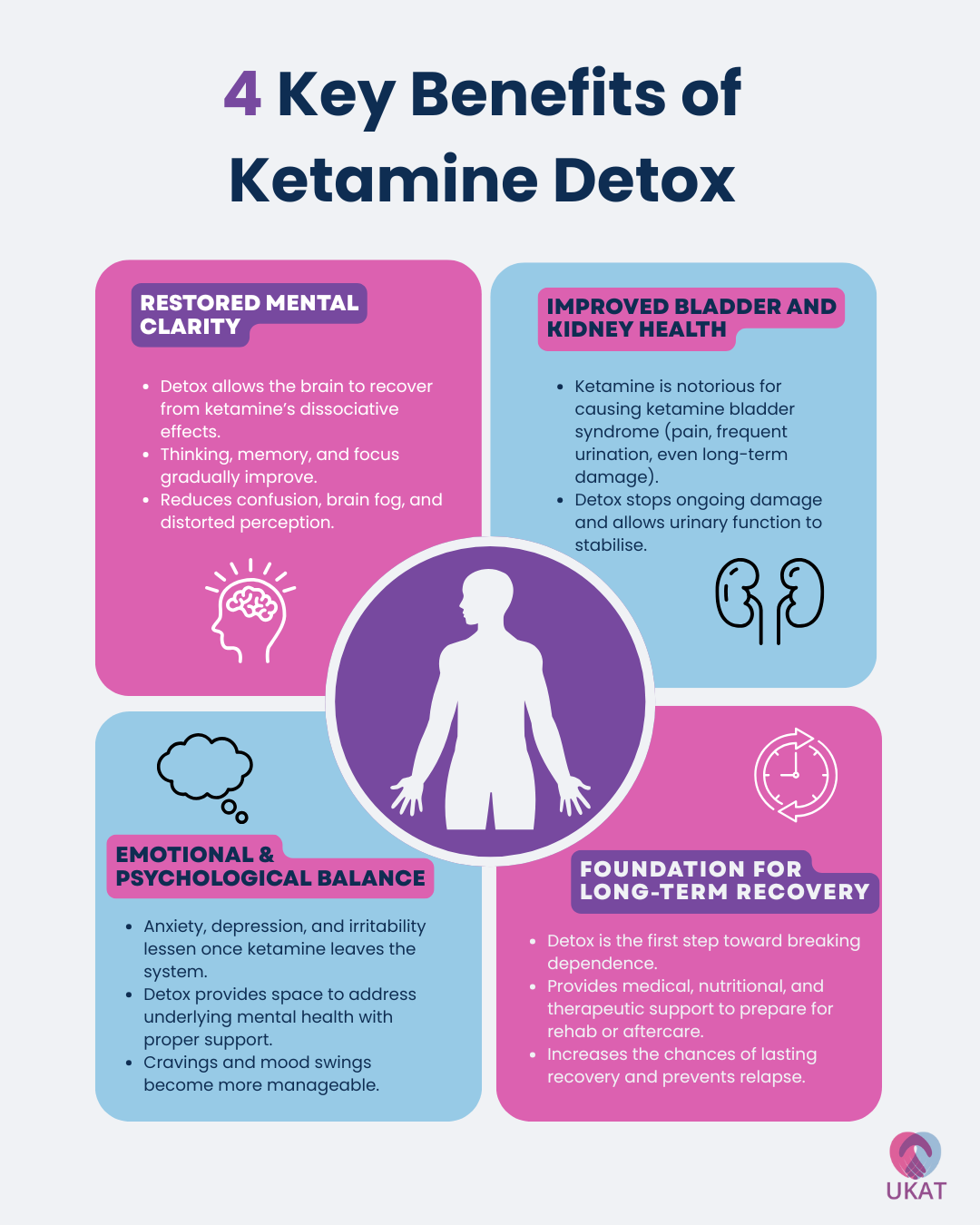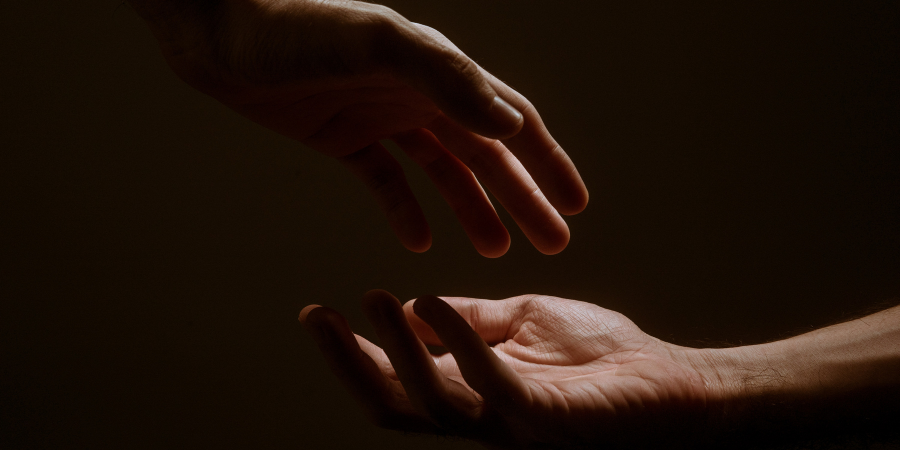
Written by:

Medically Reviewed by:
Last Updated:
October 7th, 2025
Ketamine detox
There was a time when ketamine was considered by many users to be the “safest” illegal drug, but we now know that it is anything but safe. Ketamine addiction and abuse have become major issues in the UK, with many users facing serious health and personal issues. Whatever brought you here, you are not broken or beyond help. Ketamine detox offers a safe way to quit ketamine, start healing and begin the longer-term work of building a better life without it.

What is ketamine detox?
Ketamine detox takes place during the primary care phase of the UKAT treatment pathway, and simply means stopping ketamine and giving your body time to clear it and reset. That sounds easy enough to people who have never experienced a drug addiction, but quitting can be a gruelling challenge on your own.
Ketamine is a dissociative that scrambles normal messaging in your brain. That is why it makes you feel detached, floaty or “out of body.” Over time, the brain adapts to that interference, so when you take ketamine away your system needs a period of quiet to rebalance. It is that adjustment which brings on ketamine withdrawal symptoms.
While “ketamine detox” means any period of quitting, professional ketamine detox is a structured pause, planned and often overseen by staff who know the right way to do it safely. UKAT provides ketamine detox at our centres, and we have already helped thousands of people just like you defeat addiction forever.
What does the ketamine detox process involve?
At UKAT, the ketamine detox process begins with an honest conversation about your struggles and needs. While all of our centres provide ketamine detox, the support available at each is different. This initial conversation with our team means we can advise you which centre is best, whether that’s for extra medical support, or even just because you want to detox closer to home.
When you arrive at your chosen centre, our doctors then conduct a full medical assessment. The aim is to get a complete idea of:
- Your current and past ketamine use
- Other substances you have been using
- Your mental and physical health, such as any feelings of depression, sleep issues, or problems with your bladder or bowels (very common with ketamine use)
- Any prescription medications you are taking and why (to prevent any dangerous interactions with ketamine detox medication)
- Any past attempts to quit ketamine
A ketamine detox plan can then be designed around all of this so that withdrawal symptoms and risks can be anticipated and properly managed. Most importantly, and a major reason why we create individual detox plans, it can then be adjusted if your needs change.
Our team knows how to handle cravings, mood crashes and all the practical things like food, fluids, and creating a restful environment. Our job is to make the hardest times passable, and then slowly introduce you to therapy with no pause in treatment. All of this won’t make ketamine detox “easy” or prevent any discomfort, but it is far safer and less scary than going it alone.

What is ketamine withdrawal?
Most people imagine withdrawal as shivers and sickness, from scenes they may have seen on television and in films of people going “cold turkey”. But ketamine is mainly a head and mood crash, with some physical discomfort on top. However, one physical symptom that we see a lot at UKAT is bladder issues, which are incredibly common among ketamine users and can get worse during withdrawal. Other common but generally manageable ketamine withdrawal symptoms are:
- Feeling low, anxious, irritable or just unable to settle or feel comfortable
- Ketamine cravings (these are relatively rare among hallucinogenic drugs but are common with ketamine withdrawal)
- Foggy thinking, memory loss and finding it hard to concentrate
- Insomnia, tossing and turning and strange, scary dreams
- Tiredness, headaches, and unpredictable appetite
However, there are some other ketamine withdrawal symptoms which are less common but can be far more serious and need extra support:
- Intense agitation
- Panic attacks
- Dark, depressive thoughts
- Feelings of hopelessness
- Confusion or feeling like nothing isn’t real (dissociation) without ketamine
- Severe bladder pain or blood in urine
During ketamine detox planning, the risk of these complications can be anticipated during your medical assessment. UKAT’s doctors and other staff can then take every step necessary to manage them and adjust your plan if we need to.
How long does ketamine withdrawal last?
The answer to this question is not exactly set in stone because everybody is different. If you have underlying health conditions, have been using a lot of ketamine for a while, or are using multiple drugs and even drinking a lot, the ketamine detox timeline can be longer with potentially more difficult symptoms. However, to give you some idea of what to expect before we have assessed you fully, here is a general timeline for reference:

Why inpatient ketamine detox beats detoxing at home
At home, ketamine withdrawal symptoms can make it very easy to relapse during detox. Even if you quit successfully, the earliest days after detox are the most vulnerable. When you are still surrounded by triggers like your friends, social scene, and access to drugs, it can be easy to go right back to where you started.
NHS services exist and can be helpful, but are often outpatient (appointments by day, home at night) with waiting lists and no 24/7 cover. Inpatient detox removes you from your triggers, keeps you safe around the clock, and moves you straight into therapy the moment you’re ready.
Who can see the benefits of ketamine withdrawal?
The short answer is anybody addicted to ketamine, and even those who are using it. This is very important to understand because we now know that any amount of ketamine use can have serious health and personal consequences. If any of these feel familiar, detox could help:
The “only at weekends” users who have lost control
As addiction develops, ketamine use can quickly grow from just nights out into daytime top-ups and eventually a 24/7 reliance. This growing dependency is often the first sign that you are developing a full-blown addiction, with huge impacts on your health and everyday life.
People with bladder pain, urgency, burning or accidents
This is one of the telltale signs that ketamine abuse is already causing major damage to your physical health. Ketamine detox is the fastest way to stop making it worse and prevent any irreparable harm.
Anyone struggling with mood, memory or sleep
These are also early signs of ketamine use spiralling into addiction, but ketamine detox can give your brain a breather and help it get back to normal.
Polydrug users and those drinking a lot with ketamine
Because many people use ketamine as a party drug, mixing it with alcohol, cocaine, ecstasy, and other substances is very common. This can make withdrawal messier and relapse more likely, so professional detox planning becomes crucial.
Anyone who has quit ketamine before and relapsed
If you have previously managed to stop for a while but have gone back to using ketamine, then don’t be too hard on yourself. Unfortunately, that is all too common when people detox without professional help and without following up with rehab therapy.
What happens after ketamine detox
Detox clears ketamine from your system, but it doesn’t change the habits, feelings, people and places that fed your use. That is therapy’s job, and we start it immediately after detox under the same roof.
Everyone receives a full programme of rehab therapies at a UKAT recovery centre, including:
- One-to-one counselling
- Group therapy
- Trauma therapy
- Family therapy sessions
- Holistic therapies
However, every UKAT centre offers a slightly different mix, so check our centre pages or speak to us directly, and we will match you to the programme that fits your needs and personality.
No matter which UKAT centre you choose, you will leave with a relapse prevention plan. This means you can take proactive steps to avoid a relapse and act quickly if you’re struggling. We also provide aftercare and a fantastic alumni community, all free of charge, and all designed for practical recovery support.
What ketamine withdrawal medication will I receive?
There is no standard medication for ketamine withdrawal. Instead, treatment focuses on helping you through the symptoms that you experience.
Your doctors may prescribe short-term anxiety or sleep medication to get you through the most unsettled days. Painkillers or bladder medication can also be used if those issues come up. The goal isn’t to medicate heavily, but to make the process safe and humane so you can move on to therapy once your body has cleared the drug.
Contact us today to begin inpatient ketamine detox
The biggest breakthrough in recovery always comes the moment you realise you don’t need ketamine anymore. Once you understand that, ketamine detox and ketamine rehab are a huge leap forward to a life that you may have started to believe was no longer possible. If you are ready to start, or you just want to ask a few questions, contact UKAT today. We can talk it all through, map the next steps, and stay by your side through the hard days and the hopeful ones. You bring the courage, and we will provide everything else you need.


